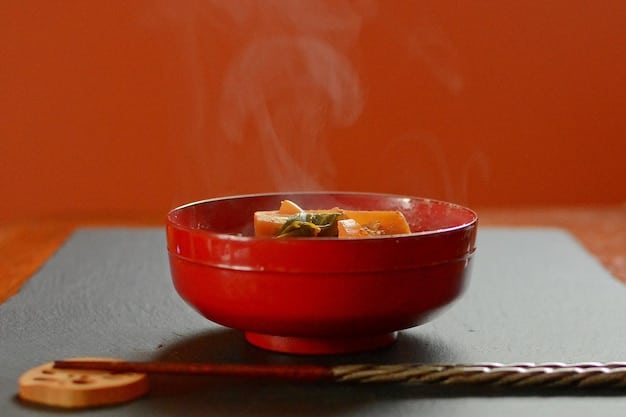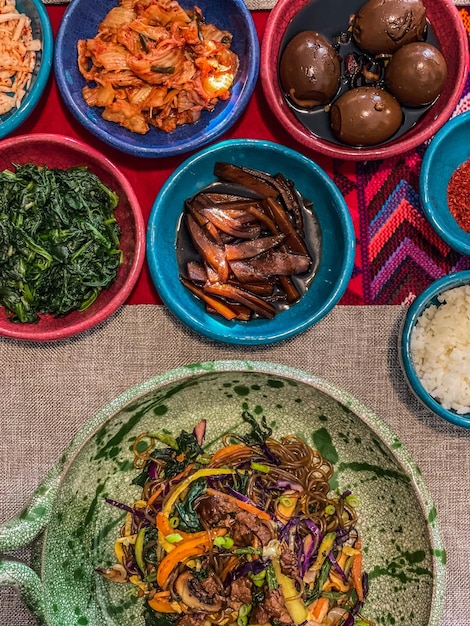Korean Drama Food Trends: Recreate Dishes from Your Favorite Shows

Korean drama food trends have surged in popularity, inspiring viewers to recreate iconic dishes like tteokbokki, kimchi jjigae, and jajangmyeon, bringing a taste of their favorite shows into their own kitchens.
Korean dramas, or K-dramas, have captivated audiences worldwide not only with their compelling storylines and charismatic characters but also with their mouthwatering depictions of Korean cuisine. The Korean drama food trends often see dishes featured in popular shows surge in demand, with fans eager to recreate them at home and experience a taste of their favorite on-screen moments. From spicy street food to comforting stews, these culinary trends offer a delicious way to connect with Korean culture.
Exploring the Rise of Food in Korean Dramas
Food plays a central role in Korean culture, often symbolizing connection, comfort, and celebration. In K-dramas, meals are not merely a backdrop but are integral to storytelling, revealing character relationships and highlighting cultural traditions. The visual appeal and emotional significance of these food scenes have contributed significantly to the rise of Korean drama food trends.
The Cultural Significance of Food in K-Dramas
Korean dramas often emphasize the importance of shared meals and the communal aspect of eating. Whether it’s a family gathering around a table laden with banchan (side dishes) or a romantic encounter over a bowl of noodles, food serves as a catalyst for social interaction and emotional expression.
Key Dishes That Frequently Appear
Certain dishes appear repeatedly across various K-dramas, gaining iconic status among viewers. These include staples like kimchi, bibimbap, and Korean BBQ, as well as more specialized fare like ramyeon and various types of stews. Their consistent presence reinforces their cultural importance and sparks viewers’ curiosity to try them for themselves.
- Kimchi: A fermented cabbage dish that is a cornerstone of Korean cuisine. It appears in almost every meal in K-dramas.
- Bibimbap: A mixed rice dish with vegetables, meat, and a fried egg, often served with gochujang (chili pepper paste).
- Korean BBQ: Grilled meats, typically marinated, served with lettuce wraps and an array of side dishes.
- Ramyeon: Instant noodles that come in countless varieties and are frequently enjoyed as a quick and satisfying meal.
These frequent appearances in K-dramas have created a surge of interest, making them staples in Korean drama food trends.
The appeal of food in Korean dramas extends beyond its presentation; it evokes emotions and memories, making viewers feel more connected to the characters and their stories. This emotional connection is a key driver of the desire to recreate these dishes at home.
Iconic Dishes and How to Recreate Them
Many K-drama fans are inspired to try cooking the dishes they see on screen. While some recipes may seem daunting, many are surprisingly accessible. Here’s a look at some of the most popular dishes and how to recreate them at home.
Tteokbokki (Spicy Rice Cakes)
Tteokbokki is a beloved Korean street food made from chewy rice cakes, gochujang (chili paste), and other ingredients. Its spicy and savory flavors make it a favorite snack or meal, often featured in K-dramas during scenes of friends gathering or enjoying outdoor events.
Recipe Tips: To make tteokbokki, you’ll need Korean rice cakes (tteok), gochujang, gochugaru (chili flakes), fish cakes, and vegetables like onions and scallions. Simmer the ingredients in water until the rice cakes are soft and the sauce has thickened. Adjust the amount of gochujang and gochugaru to your preferred spice level.
Kimchi Jjigae (Kimchi Stew)
Kimchi jjigae is a hearty and flavorful stew made with fermented kimchi, tofu, pork (or other meat), and vegetables. It’s a staple in Korean households and a common comfort food, often depicted in K-dramas as a warm and nourishing meal enjoyed on cold days.
Recipe Tips: The key to a good kimchi jjigae is well-fermented kimchi. Sauté the kimchi with pork or beef, then add broth or water and simmer with tofu, onions, and scallions. Season with gochujang and soy sauce to taste. The longer it simmers, the more flavorful it becomes.

Jajangmyeon (Black Bean Noodles)
Jajangmyeon is a popular noodle dish with a thick black bean sauce, typically served with diced pork and vegetables. It’s often associated with special occasions and celebrations in K-dramas, making it a favored dish for get-togethers and comforting meals.
- Sauce Preparation: The sauce is made from chunjang (Korean black bean paste), which is stir-fried with diced pork, onions, and other vegetables.
- Noodle Type: Use thick, chewy wheat noodles for the best texture.
- Garnish: Cucumber slices and pickled radish are common garnishes.
These dishes are not only delicious but also provide a glimpse into the culinary culture portrayed in K-dramas.
Recreating these dishes can bring a sense of connection to the shows and characters you love, making the viewing experience even more immersive.
Incorporating Korean Ingredients into Your Cooking
One of the most exciting aspects of exploring Korean drama food trends is experimenting with new ingredients. Many Korean ingredients have unique flavors and textures that can elevate your cooking, but knowing where to find them and how to use them is essential.
Essential Korean Ingredients
To recreate authentic Korean dishes, you’ll need to familiarize yourself with key ingredients like gochujang, gochugaru, doenjang, and sesame oil. These staples are the foundation of many Korean recipes and contribute distinctive flavors.
Where to Find Them: Most of these ingredients can be found at Asian grocery stores or online. Look for reputable brands to ensure quality and authenticity. Some larger supermarkets may also carry a selection of Korean ingredients in their international aisle.
Tips for Using Korean Sauces and Pastes
Korean sauces and pastes, such as gochujang and doenjang, are potent flavor enhancers. A little goes a long way, so start with small amounts and adjust to taste. These ingredients can add depth, spice, and umami to your dishes.
- Gochujang: Use in stews, sauces, and marinades for a spicy and slightly sweet flavor.
- Gochugaru: Add to kimchi, soups, and stews for a vibrant red color and a chili kick.
- Doenjang: Use in soups and stews for a savory, earthy flavor.
By understanding how to use these ingredients, you can unlock the authentic flavors of Korean cuisine and bring your favorite K-drama dishes to life.
Exploring these ingredients can open up a whole new world of culinary possibilities and help you appreciate the nuances of Korean cooking.
Health Benefits of Korean Cuisine
Beyond their delicious flavors, many Korean dishes offer significant health benefits. The combination of fresh vegetables, fermented foods, and lean proteins makes Korean cuisine a nutritious and balanced choice. The focus on natural, whole foods aligns with a healthy lifestyle.
The Role of Fermented Foods
Fermented foods like kimchi, doenjang, and gochujang are rich in probiotics, which promote gut health and boost the immune system. These foods have been a staple in Korean diets for centuries and are known for their health-promoting properties.
Specific Benefits: Probiotics can improve digestion, reduce inflammation, and enhance nutrient absorption. Regularly consuming fermented foods can have a positive impact on overall health and well-being.
Nutrient-Rich Ingredients
Many Korean dishes are packed with nutrient-rich ingredients like vegetables, tofu, and seafood. These foods provide essential vitamins, minerals, and antioxidants, contributing to a healthy and balanced diet. The emphasis on fresh, seasonal produce ensures that meals are both flavorful and nutritious.

Examples: Dishes like bibimbap, which includes a variety of vegetables and a lean protein source, and seaweed soup (miyeok guk), which is rich in minerals, exemplify the health benefits of Korean cuisine.
By incorporating more Korean dishes into your diet, you can enjoy delicious meals while also benefiting from the health-promoting properties of Korean cuisine.
The health benefits of Korean cuisine add another layer of appeal to the Korean drama food trends, making it a healthful and delicious culinary journey.
Adapting K-Drama Recipes for Different Dietary Needs
While traditional Korean recipes are delicious, they may not always suit everyone’s dietary needs. Whether you’re vegetarian, vegan, gluten-free, or have other restrictions, there are ways to adapt K-drama-inspired dishes to fit your lifestyle.
Vegetarian and Vegan Options
Many Korean dishes can be easily adapted to be vegetarian or vegan by substituting meat with tofu, mushrooms, or other plant-based proteins. Vegetable-based banchan and noodle dishes can be enjoyed without modification.
Substitution Ideas: Replace beef or pork with tofu in kimchi jjigae or bulgogi. Use vegetable broth instead of beef broth in soups and stews. Opt for vegetable-based dumplings and pancakes.
Gluten-Free Alternatives
For those with gluten sensitivities, it’s important to be mindful of ingredients like soy sauce and wheat-based noodles. Look for gluten-free soy sauce (tamari) and use rice noodles or sweet potato noodles as alternatives.
Tips for Gluten-Free Cooking: Check labels carefully to ensure ingredients are gluten-free. Use gluten-free gochujang and doenjang, as some brands may contain wheat. Opt for dishes that naturally do not contain gluten, such as bibimbap and japchae (glass noodle stir-fry).
Adapting K-drama recipes to suit your dietary needs allows you to enjoy the flavors of Korean cuisine without compromising your health or values. It shows how versatile Korean cuisine can be.
By making simple substitutions and modifications, you can continue to explore Korean drama food trends while catering to your specific dietary requirements.
The Influence of Social Media on K-Drama Food Trends
Social media platforms play a significant role in shaping and popularizing Korean drama food trends. From visually appealing food photos to viral recipe videos, social media has amplified the reach and impact of Korean cuisine worldwide. It became a primary medium for discovering new dishes.
Instagram and TikTok’s Role
Instagram and TikTok are particularly influential, with food bloggers and K-drama fans sharing their creations and experiences. These platforms provide a visual feast of Korean dishes and inspire others to try their hand at recreating them. The short-form video format of TikTok makes it easy to share quick and engaging recipe tutorials.
Impact: Hashtags like #kdramafood, #koreanfood, and #tteokbokki have millions of posts, showcasing the global interest in Korean cuisine. Influencers and everyday cooks alike share their versions of popular K-drama dishes, contributing to the trend’s momentum.
Online Communities and Forums
Online communities and forums provide spaces for K-drama fans to discuss their favorite dishes, share recipes, and ask for advice. These platforms foster a sense of community and provide valuable resources for those looking to explore Korean cuisine.
Benefits: Members can exchange tips, troubleshoot recipes, and discover new variations of popular dishes. These communities often feature reviews of restaurants and grocery stores that specialize in Korean ingredients.
Social media has democratized access to Korean cuisine, making it easier than ever to discover, learn about, and recreate your favorite K-drama dishes. The power of crowdsourcing adds to the body of accessible knowledge.
The influence of social media on Korean drama food trends is undeniable, amplifying the reach and impact of Korean cuisine worldwide, and making it possible for everyone to get involved.
| Key Point | Brief Description |
|---|---|
| 🎬 K-Drama Influence | Popular dishes from dramas inspire global culinary trends. |
| 🌶️ Iconic Dishes | Tteokbokki, Kimchi Jjigae, and Jajangmyeon are fan favorites. |
| 🌱 Essential Ingredients | Gochujang, Gochugaru, Doenjang are key for authentic flavors. |
| 🥗 Health Benefits | Fermented foods offer probiotics for gut health and overall wellness. |
Frequently asked questions
▼
The combination of visually appealing food scenes, the emotional connections viewers form with the characters, and the cultural significance of food in Korean society all contribute to the popularity of these trends.
▼
Most Korean ingredients can be found at Asian grocery stores or online retailers specializing in international foods. Some larger supermarkets may also carry a selection in their international aisle.
▼
Many Korean dishes are quite healthy, emphasizing fresh vegetables, fermented foods, and lean proteins. The focus on natural, whole foods makes it a nutritious and balanced choice.
▼
Substitute meat with tofu, mushrooms, or other plant-based proteins. Use vegetable broth instead of meat-based broths and opt for vegetable-based versions of popular dishes.
▼
Social media platforms like Instagram and TikTok amplify the reach and impact of Korean cuisine by providing a visual feast of dishes and inspiring others to recreate them through shared recipes and experiences.
Conclusion
Exploring Korean drama food trends offers a delightful way to connect with Korean culture, experiment with new flavors, and enjoy delicious and often healthy meals. By recreating iconic dishes and understanding the cultural significance of food in K-dramas, fans can immerse themselves in the world of their favorite shows in a truly unique and tasty way.





